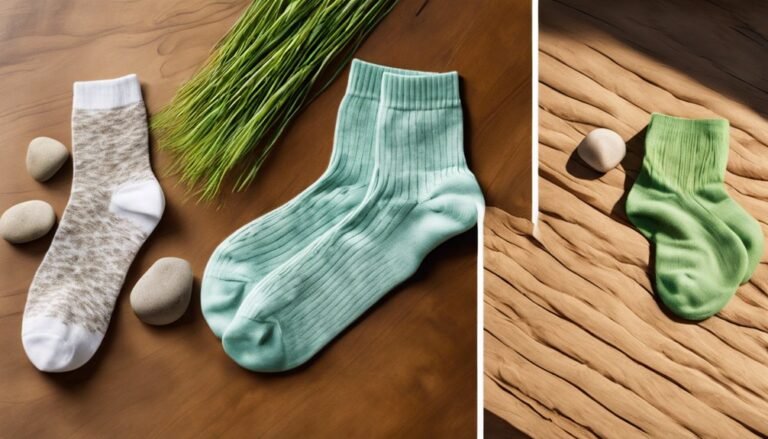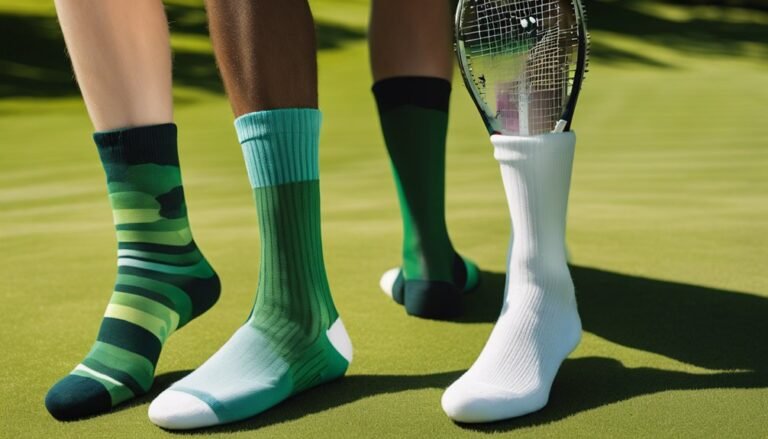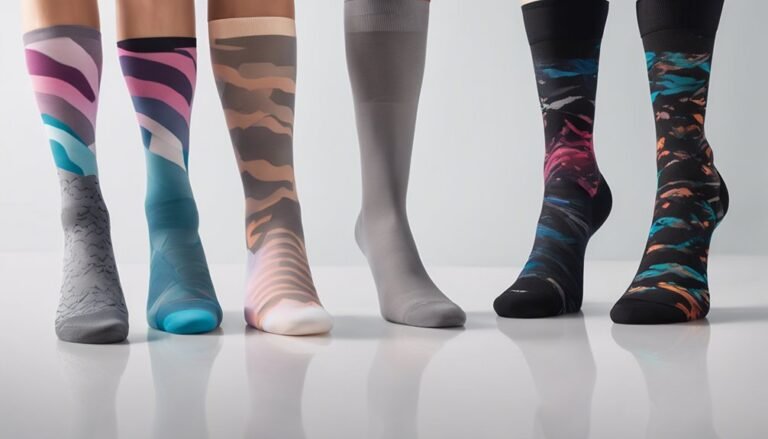Hemp Socks vs. Bamboo Socks: Which Is More Sustainable?
When comparing hemp socks to bamboo socks, hemp emerges as the more sustainable option. It requires only 600 liters of water during cultivation, starkly lower than bamboo's 1,500 liters. Hemp also avoids chemical inputs, promoting healthier soil, while bamboo needs chemicals that can deplete nutrients. In addition, hemp's rapid growth and lower carbon footprint correlate with reduced environmental impact. If you want to explore more about their unique properties and impacts, there's plenty more to reflect upon.
Understanding Hemp: A Sustainable Textile

While many textiles claim sustainability, hemp stands out as a particularly eco-friendly option due to its low environmental impact and rapid growth cycle. Historically, hemp has been cultivated for thousands of years, serving diverse applications from textiles to medicine. Its sustainability practices are rooted in its ability to grow in various climates with minimal water and pesticides, often enriching the soil it grows in. Additionally, hemp's fibers are durable, allowing for longer-lasting products, which reduces waste. The cultivation process also captures carbon, contributing positively to the environment. By choosing hemp, you're not just opting for a sustainable textile; you're participating in a movement towards responsible consumption and environmental stewardship that aligns with a desire for freedom and ecological harmony.
The Benefits of Bamboo as a Clothing Material
Bamboo's status as a renewable resource makes it an appealing choice for clothing materials. It grows rapidly without the need for pesticides, contributing to sustainable practices in the textile industry. Additionally, bamboo naturally absorbs moisture, which can enhance comfort and reduce odor in clothing.
Renewable Resource Advantage
When considering sustainable clothing materials, bamboo stands out due to its rapid growth and minimal environmental impact. Bamboo can grow up to three feet in a single day, making it one of the fastest renewable resources available. This rapid growth means it requires less land and water compared to traditional crops, aligning well with sustainable practices. Additionally, bamboo naturally regenerates without needing to be replanted, reducing soil erosion and maintaining ecological balance. Its cultivation typically requires fewer pesticides and fertilizers, further minimizing environmental harm. By choosing bamboo, you're supporting a material that not only meets your clothing needs but also promotes a more sustainable future. This commitment to renewable resources empowers you to make environmentally conscious choices in your wardrobe.
Natural Moisture Absorption
Because of its unique fiber structure, bamboo offers superior natural moisture absorption compared to many other materials used in clothing. This characteristic makes bamboo an excellent choice for those seeking effective moisture management in their wardrobe. Here are three benefits of bamboo's absorption efficiency:
- Breathability: Bamboo fibers allow air to circulate, reducing sweat buildup.
- Quick Drying: The material absorbs moisture quickly, helping you stay dry and comfortable.
- Odor Resistance: Bamboo can inhibit the growth of bacteria, minimizing odor even after prolonged wear.
These properties not only enhance comfort but also contribute to a more sustainable lifestyle. By choosing bamboo, you're investing in a material that supports both your well-being and environmental health.
Production Processes: Hemp vs. Bamboo
When comparing the production processes of hemp and bamboo socks, it's crucial to take into account the cultivation methods for each plant. You'll find that their resource requirements and environmental impacts differ considerably, influencing their sustainability. Analyzing these factors can help you make a more informed decision about which material aligns with your values.
Cultivation Methods Comparison
While both hemp and bamboo are celebrated for their eco-friendly attributes, their cultivation methods reveal significant differences in production processes. Hemp thrives in diverse climates and often benefits from crop rotation, which enhances soil health and reduces pest issues. Conversely, bamboo grows rapidly and can be cultivated without pesticides, but it typically requires specific tropical conditions.
Here's a quick comparison:
- Sustainability: Hemp supports soil health through crop rotation, while bamboo requires less chemical intervention.
- Growth Rate: Bamboo can reach maturity in 3-5 years, whereas hemp takes about 4 months.
- Land Use: Hemp can be grown in various regions, while bamboo is more location-restricted.
These factors contribute to the overall sustainability of each crop in textile production.
Resource Requirements Analysis
The differences in cultivation methods between hemp and bamboo also extend to their resource requirements during production. Hemp generally requires fewer cultivation inputs, showcasing greater resource efficiency. In contrast, bamboo, while fast-growing, often needs more water and chemical treatments.
| Crop | Water Usage (liters) | Chemical Inputs (kg) |
|---|---|---|
| Hemp | 600 | 0 |
| Bamboo | 1,500 | 5 |
This table illustrates that hemp's minimal cultivation inputs make it a more sustainable choice regarding resource requirements. The lower water usage and absence of chemical treatments not only enhance resource efficiency but also align with a desire for environmentally responsible products. Consequently, when considering sustainability, hemp socks emerge as the superior option.
Environmental Impact Assessment
Although both hemp and bamboo are often touted for their eco-friendly properties, a closer look at their production processes reveals significant differences in their environmental impact. Hemp generally has a lower carbon footprint due to its ability to grow quickly without pesticides and its minimal water requirements. In contrast, bamboo requires more intensive processing to convert it into a usable fiber, which can increase its environmental impact.
Here are three considerations for sustainable practices in production:
- Water Usage: Hemp needs less water than bamboo during cultivation.
- Pesticide Dependency: Hemp relies less on chemical treatments.
- Processing Methods: Bamboo often undergoes chemical processes that can harm ecosystems.
Environmental Impact: Comparing Resource Use
When considering the environmental impact of hemp socks versus bamboo socks, it's essential to examine their resource use throughout the production process. Hemp typically requires less water usage, thriving in diverse climates and needing minimal irrigation. This makes it a strong candidate for sustainable practices. In contrast, bamboo often demands more water and specific conditions for growth, which can strain local resources. Additionally, hemp's deep roots improve soil health by preventing erosion and enhancing nutrient availability, which is beneficial for the ecosystem. Bamboo, while fast-growing, can deplete soil nutrients when over-harvested. Ultimately, when you weigh the resource use of these materials, hemp socks appear to offer a more sustainable path for environmentally conscious consumers.
Durability and Comfort: How Do They Measure Up?

While both hemp and bamboo socks offer unique benefits, their durability and comfort levels can greatly influence consumer choices. Durability testing reveals that hemp socks often outperform bamboo in longevity, making them a solid option for those prioritizing wear-and-tear resistance. On the other hand, bamboo socks provide exceptional softness, enhancing overall comfort levels.
Here are three key points to reflect on:
- Hemp Socks: Known for their strength, they resist fraying and wear, ensuring a longer lifespan.
- Bamboo Socks: Their silky texture offers immediate comfort, ideal for sensitive skin.
- Care Requirements: Hemp may require more specific care to maintain durability, while bamboo is generally easier to wash.
Ultimately, your choice may hinge on whether you value durability or immediate comfort more.
Biodegradability and End-of-Life Options
The environmental impact of clothing extends beyond durability and comfort, bringing biodegradability and end-of-life options into focus. When considering hemp and bamboo socks, you'll find that both are made from biodegradable materials, making them preferable to traditional synthetic options. Hemp decomposes relatively quickly, enriching the soil upon breakdown, while bamboo also boasts a swift degradation process.
However, your end-of-life options matter. With both types of socks, you can compost them rather than sending them to a landfill, promoting a circular economy. Still, it's crucial to check for blends; synthetic fibers can hinder biodegradability. Ultimately, understanding these aspects helps you make informed choices that align with your values of sustainability and environmental responsibility.
Making the Choice: Which Is Right for You?
How do you determine which type of sock—hemp or bamboo—best suits your needs? It really comes down to your personal preferences and socks style. Here are three key factors to weigh:
- Comfort: Hemp tends to be more rigid, while bamboo offers a softer feel. Think about what feels best against your skin.
- Durability: Hemp socks are generally more resilient, ideal for heavy wear. If longevity is your priority, this could be a deciding factor.
- Moisture Management: Bamboo excels in moisture-wicking properties, keeping your feet dry. If you lead an active lifestyle, this might sway your choice.
Evaluate these aspects carefully, and you'll find the sock that aligns with your values and lifestyle.
Frequently Asked Questions
Can Hemp or Bamboo Socks Cause Allergic Reactions?
You might worry about allergic reactions, but both hemp and bamboo are generally hypoallergenic. However, if you have skin sensitivity, you should test them first to guarantee they don't irritate your skin.
How Do Hemp and Bamboo Socks Compare in Price?
When you consider price comparison, hemp socks typically cost more upfront but offer durability. Bamboo socks may be cheaper, yet they often wear out faster. Evaluating cost effectiveness depends on your preferences for longevity versus initial investment.
Are There Specific Care Instructions for Hemp or Bamboo Socks?
When it comes to care instructions for your socks, follow washing guidelines like cold water washes and air drying. This approach helps maintain their quality and guarantees they last longer, giving you more freedom in your wardrobe choices.
Where Can I Buy Sustainable Hemp or Bamboo Socks?
Looking for sustainable socks? You've got options! Check online retailers like Amazon or specialized sustainable brands like Pact and Conscious Step. They offer eco-friendly choices that align with your values while keeping your feet comfy.
Do Hemp or Bamboo Socks Have a Stronger Odor Retention?
When it comes to odor retention, both fabrics offer decent odor management. Hemp's natural breathability may help reduce odors more effectively than bamboo, but individual experiences can vary based on usage, moisture, and personal body chemistry.







